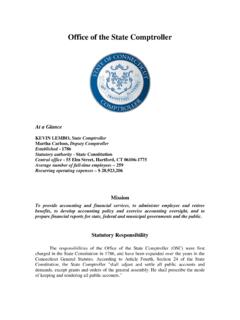Transcription of John Kotter’s Eight Step Change Model - Connecticut
1 John Kotter s Eight Step Change Model John Kotter (1996), a Harvard Business School Professor and a renowned Change expert, in his book Leading Change , introduced an 8 Step Model of Change which he developed on the basis of research of 100 organizations which were going through a process of Change . The 8 steps in the process of Change include: creating a sense of urgency, forming powerful guiding coalitions, developing a vision and a strategy, communicating the vision, removing obstacles and empowering employees for action, creating short-term wins, consolidating gains and strengthening Change by anchoring Change in the culture . Kotter s 8 step Model can be explained with the help of the illustration given below: (Source: Adapted from Kotter 1996) 1.
2 Creating an Urgency: This can be done in the following ways: Identifying and highlighting the potential threats and the repercussions which might crop up in the future. Examining the opportunities which can be tapped through effective interventions. Initiate honest dialogues and discussions to make people think over the prevalent issues and give convincing reasons to them. Request the involvement and support of the industry people, key stakeholders and customers on the issue of Change . 2. Forming Powerful Guiding Coalitions This can be achieved in the following ways: Identifying the effective Change leaders in your organizations and also the key stakeholders, requesting their involvement and commitment towards the entire process.
3 Form a powerful Change coalition who would be working as a team. Identify the weak areas in the coalition teams and ensure that the team involves many influential people from various cross functional departments and working in different levels in the company. 3. Developing a Vision and a Strategy This can be achieved by: Determining the core values, defining the ultimate vision and the strategies for realizing a Change in an organization. Ensure that the Change leaders can describe the vision effectively and in a manner that people can easily understand and follow. 4. Communicating the Vision Communicate the Change in the vision very often powerfully and convincingly. Connect the vision with all the crucial aspects like performance reviews, training, etc.
4 Handle the concerns and issues of people honestly and with involvement. 5. Removing Obstacles Ensure that the organizational processes and structure are in place and aligned with the overall organizational vision. Continuously check for barriers or people who are resisting Change . Implement proactive actions to remove the obstacles involved in the process of Change . Reward people for endorsing Change and supporting in the process. 6. Creating Short-Term Wins By creating short term wins early in the Change process, you can give a feel of victory in the early stages of Change . Create many short term targets instead of one long-term goal, which are achievable and less expensive and have lesser possibilities of failure.
5 Reward the contributions of people who are involved in meeting the targets. 7. Consolidating Gains Achieve continuous improvement by analysing the success stories individually and improving from those individual experiences. 8. Anchoring Change in the Corporate culture Discuss the successful stories related to Change initiatives on every given opportunity. Ensure that the Change becomes an integral part in your organizational culture and is visible in every organizational aspect. Ensure that the support of the existing company leaders as well as the new leaders continue to extend their support towards the Change . Advantages of Kotter s Model It is an easy step by step Model which provides a clear description and guidance on the entire process of Change and is relatively easy for being implemented.
6 Emphasis is on the involvement and acceptability of the employees for the success in the overall process. Major emphasis is on preparing and building acceptability for Change instead of the actual Change process. Retrieved from: on 5/30/2018















